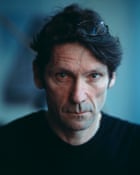A refugee in a Parisian underpass: Myr Muratet’s best photograph
[ad_1]
I took this eight years ago in an underpass beneath the metro line that runs through the north of Paris. The place used to be a haven for hundreds of refugees, mostly from Africa. It’s near La Chapelle station, between Gare du Nord and the intersection of very popular Indian, Arab and African neighbourhoods; it’s wind-beaten and extremely noisy because of the constant movement of the trains.
I’ve been a photographer for 40 years, and started taking photographs in La Chapelle 20 years ago because it’s my neighbourhood and it seemed necessary, politically, to develop my work locally. I hung out in this square and came to know many people from Sudan, Ethiopia and Eritrea, but I had never seen this young man before. We didn’t talk much and I know almost nothing about him. He spoke a little English and a little Arabic, he was from Eritrea and had just arrived in Paris. Like many refugees, he had travelled here across Libya, the Mediterranean and then Italy. He was planning to leave for Calais the next day to try to get to England.
I think he had found his clothes at a local charity. I thought he looked incredibly classy in his turquoise coat and pink scarf, tied in the Tuareg way. He was tying his scarf when I met him – it was a winter evening and this spot under the bridge is especially windy and cold. Everyone had covered themselves as best they could with whatever they had.
It matters that the people I shoot are aware they are being photographed, and I was happy he agreed I could take his picture. I took two, one horizontal, one vertical, but I wasn’t able to show him the result because I never saw him again. The underpass was later evacuated by the police and has since been secured by fences and is guarded by dogs. Many of the refugees have settled around the Porte de la Chapelle, on the northern periphery of Paris.
This image is part of a larger project about young refugees in Paris, and follows on from another about a group of homeless people who lived in the Gare du Nord but have since died or disappeared. Another ongoing series, Wasteland, follows a Roma community in otherwise abandoned areas in the north of the city. I photograph the people but I also try to show their homes, and the way they survive economically. I don’t look for distress in the people I shoot, I study their ability to survive.
I’m driven by curiosity; by how, in a city like Paris which is watched and policed, life settles illegally in all its interstices. By how people organise themselves, pool their efforts and means, and resist. I also try to document the devices that the French government and the city of Paris have put in place to constrain or chase them away. These devices can be physical, such as benches you can’t lie down on or the boulders and fences placed at the entrances of vacant lots, but they also include dog handlers and the police. With the approach of the Olympic Games [to be hosted by Paris in 2024], the state and the mayor of Paris have undertaken to clear the city of its destitute. There are no more large refugee camps or slums in the city or its surroundings. The poor and the homeless have been pushed out of the visual field of the future tourists.
My photographs show nothing Parisians don’t already know. Over the years there were kilometres of tents on the pavements and canal banks housing hundreds of refugees at all times of year. We couldn’t miss them, though they were regularly chased away and pushed further and further outside the city limits.
I grew up in the east of Paris in the ceinture rouge [the “red belt”, the traditionally socialist working-class areas around the capital]. I was brought up by a militant mother who spent her evenings in meetings and never missed a demonstration. It put me off activism but gave me a strong political awareness. Of course I am conscious of the differences between me and the people I photograph. I am white and I have a roof over my head. My country is still colonialist – consciously and factually racist. With this background it is hard to establish a relationship of equality with African refugees at first sight. I don’t think my images necessarily help the people I photograph but they help me and others to see them better.

Myr Muratet CV
Born: Paris, 1959
Trained: “A photographic studio in Hamburg, Germany.”
Influences: “Karl Marx and the poet and friend Manuel Joseph.”
High point: “When the Roma I had been photographing for years started referring to me as the ‘manuch’ (the guy) instead of the ‘gadjo’ (the foreigner).”
Low point: “Getting caught up in details.”
Top tip: “Don’t bite the hand that feeds you … eat it.”
[ad_2]
Read More:A refugee in a Parisian underpass: Myr Muratet’s best photograph

Comments are closed.